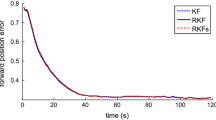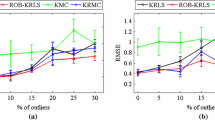Abstract
A robust Kalman filter scheme is proposed to resist the influence of the outliers in the observations. Two kinds of observation error are studied, i.e., the outliers in the actual observations and the heavy-tailed distribution of the observation noise. Either of the two kinds of errors can seriously degrade the performance of the standard Kalman filter. In the proposed method, a judging index is defined as the square of the Mahalanobis distance from the observation to its prediction. By assuming that the observation is Gaussian distributed with the mean and covariance being the observation prediction and its associate covariance, the judging index should be Chi-square distributed with the dimension of the observation vector as the degree of freedom. Hypothesis test is performed to the actual observation by treating the above Gaussian distribution as the null hypothesis and the judging index as the test statistic. If the null hypothesis should be rejected, it is concluded that outliers exist in the observations. In the presence of outliers scaling factors can be introduced to rescale the covariance of the observation noise or of the innovation vector, both resulting in a decreased filter gain. And the scaling factors can be solved using the Newton’s iterative method or in an analytical manner. The harmful influence of either of the two kinds of errors can be effectively resisted in the proposed method, so robustness can be achieved. Moreover, as the number of iterations needed in the iterative method may be rather large, the analytically calculated scaling factor should be preferred.








Similar content being viewed by others
References
Bekir E (2007) Introduction to modern navigation systems. World Scientific, Beijing
Boncelet CG, Dickinson BW (1983) An approach to robust Kalman filtering. In: The 22nd IEEE conference on decision and control, IEEE, pp 304–305
Chang D, Wu W (2000) Feedback median filter for robust preprocessing of glint noise. IEEE Trans Aerospace Electron Syst 36:1026–1035
Chang L, Hu B, Chang G, Li A (2012a) Huber-based novel robust unscented Kalman filter. IET Sci Meas Technol 6:502–509
Chang L, Hu B, Chang G, Li A (2012b) Multiple outliers suppression derivative-free filter based on unscented transformation. J Guid Control Dyn 35:1902–1907
Chang L, Hu B, Chang G, Li A (2013) Robust derivative-free Kalman filter based on Huber’s M-estimation methodology. J Process Control 23:1555–1561
Dennis J, Schnabel R (1987) Numerical methods for unconstrained optimization and nonlinear equations. Prentice-Hall, New Jersey
Duan Z, Zhang J, Zhang C, Mosca E (2006) Robust H2 and H\(\infty \) filtering for uncertain linear systems. Automatica 42:1919–1926
Gandhi MA, Mili L (2010) Robust Kalman filter based on a generalized maximum-likelihood-type estimator. IEEE Trans Signal Process 58:2509–2520
Gordon N, Salmond D, Smith A (1993) Novel approach to nonlinear/non-Gaussian Bayesian state estimation. IEE Proc F Radar Signal Process 140:107–113
Hajiyev C, Soken HE (2012) Robust estimation of UAV dynamics in the presence of measurement faults. J Aerospace Eng 25:80–89
Hampel F (1971) A general qualitative definition of robustness. Ann Math Stat 42:1887–1896
Hewer G, Martin R, Zeh J (1987) Robust preprocessing for Kalman filtering of glint noise. IEEE TransAerospace Electron Syst 23:120–128
Huang G, Zhang Q (2012) Real-time estimation of satellite clock offset using adaptively robust Kalman filter with classified adaptive factors. GPS Solutions 16:531–539
Huber P (1972) Robust statistics: a review. Ann Math Stat 43:1041–1067
Izenman AJ (2008) Modern multivariate statistical techniques: regression, classification, and manifold learning. Springer, Berlin
Julier S, Uhlmann J, Durrant-Whyte H (2000) A new method for the nonlinear transformation of means and covariances in filters and estimators. IEEE Trans Autom Control 45:477–482
Kalman R (1960) A new approach to linear filtering and prediction problems. J Basic Eng 82:35–45
Karlgaard CD, Schaub H, Crassidis J, Psiaki M, Chiang R, Ohlmeyer EJ, Norgaard M (2007) Huber-based divided difference filtering. J Guid Control Dyn 30:885–891
Kim K, Jee G, Song J (2008) Carrier tracking loop using the adaptive two-stage Kalman filter for high dynamic situations. Int J Control Autom Syst 6:948–953
Kim K, Lee J, Park C (2009) Adaptive two-stage extended Kalman filter for a fault-tolerant INS-GPS loosely coupled system. IEEE Trans Aerospace Electron Syst 45:125–137
Koch K, Yang Y (1998) Robust Kalman filter for rank deficient observation models. J Geod 72:436–441
Kovacevic B, Durovic Z, Glavaski S (1992) On robust Kalman filtering. Int J Control 56:547–562
Maronna R, Martin R, Yohai V (2006) Robust statistics. Wiley, Chichester
Schick I, Mitter S (1994) Robust recursive estimation in the presence of heavy-tailed observation noise. Ann Stat 22:1045–1080
Simon D (2006) Optimal state estimation: Kalman, H infinity, and nonlinear approaches. Wiley-Interscience, New Jersey
Soken H, Hajiyev C (2010) Pico satellite attitude estimation via robust unscented Kalman filter in the presence of measurement faults. ISA Trans 49:249–256
Wang X, Cui N, Guo J (2010) Huber-based unscented filtering and its application to vision-based relative navigation. IET Radar Sonar Navig 4:134–141
Yang Y (1991) Robust bayesian estimation. J Geod 65:145–150
Yang Y, Gao W (2007) Comparison of two fading filters and adaptively robust filter. Geo Spatial Inf Sci 10:200–203
Yang Y, He H, Xu G (2001) Adaptively robust filtering for kinematic geodetic positioning. J Geod 75:109–116
Yang Y, Song L, Xu T (2002a) Robust estimator for correlated observations based on bifactor equivalent weights. J Geod 76:353–358
Yang Y, Song L, Xu T (2002b) Robust parameter estimation for correlated geodetic observations. Acta Geod Cartogr Sin 31:95–99
Zhou D, Frank P (1996) Strong tracking filtering of nonlinear time-varying stochastic systems with coloured noise: application to parameter estimation and empirical robustness analysis. Int J Control 65:295–307
Acknowledgments
I am grateful to the associate editor and three anonymous reviewers for their valuable comments. This work was supported by the National Basic Research Program of China (973 Program, No. 2012CB719902) and the National Natural Science Foundation of China (No.41274013).
Author information
Authors and Affiliations
Corresponding author
Rights and permissions
About this article
Cite this article
Chang, G. Robust Kalman filtering based on Mahalanobis distance as outlier judging criterion. J Geod 88, 391–401 (2014). https://doi.org/10.1007/s00190-013-0690-8
Received:
Accepted:
Published:
Issue Date:
DOI: https://doi.org/10.1007/s00190-013-0690-8




